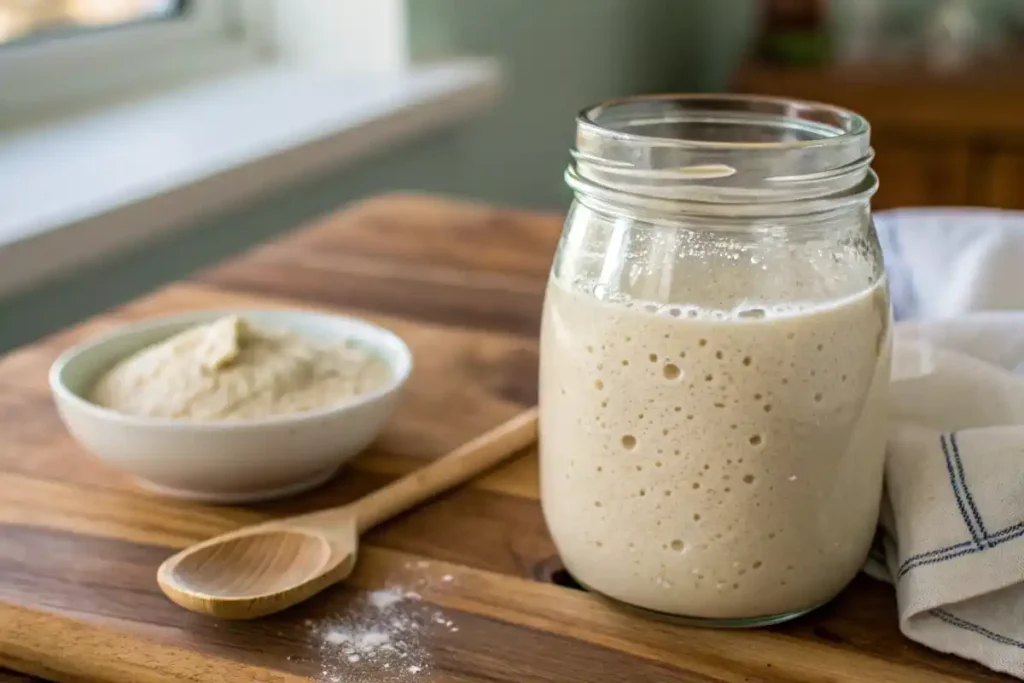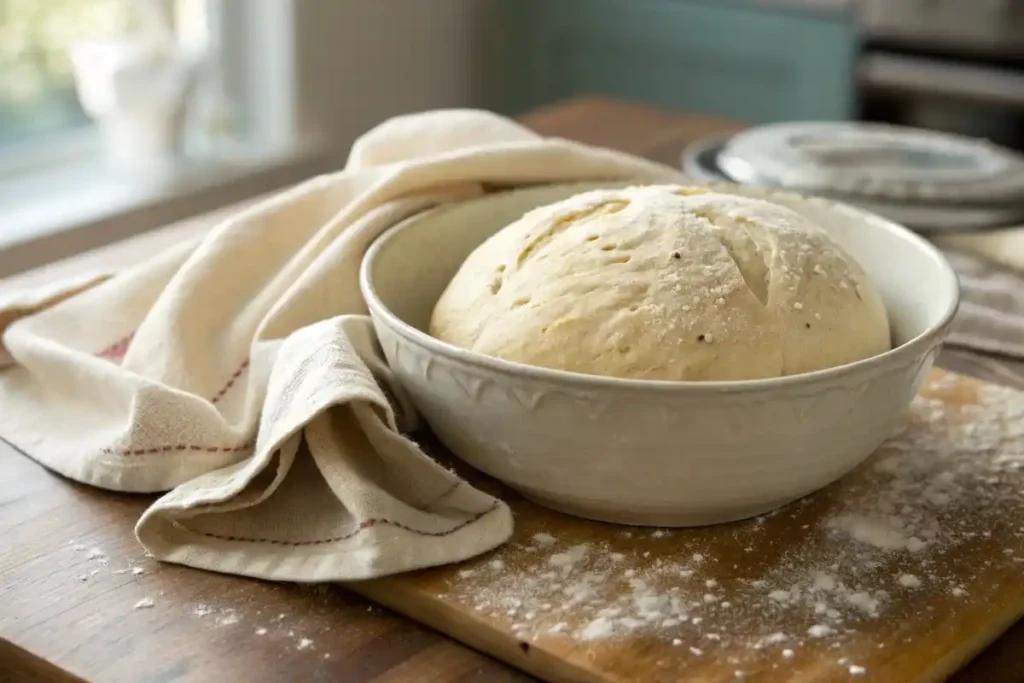There’s nothing quite like the heavenly aroma of fresh cinnamon rolls baking in the oven. But what happens when they don’t turn out as expected? Maybe your sourdough cinnamon rolls are looking a bit… well, dense. Don’t worry you’re not alone! Let’s dig into why this happens and how to fix it, so your rolls can be as light and fluffy as a cloud.
Jump ahead to:
Understanding the Basics of Sourdough Cinnamon Rolls
What Makes Cinnamon Rolls Fluffy?
Fluffiness in cinnamon rolls comes down to one thing: airiness in the dough. When yeast (or a sourdough starter) ferments, it creates tiny gas bubbles that expand the dough, making it rise. The result? Soft, pillowy rolls that practically melt in your mouth.
But here’s the catch: with sourdough, this magic depends on a delicate balance of ingredients, timing, and technique. Skip a step, and you might end up with rolls that are more brick than cloud. Not ideal, right?
“Fluffiness in baking isn’t just about ingredients it’s about letting time and technique work their magic.”
The Role of Sourdough in Baking
Sourdough isn’t just about flavor (though that tang is amazing). The natural yeast and bacteria in a sourdough starter do the heavy lifting to make your dough rise. This means no commercial yeast is needed! But with great power comes great responsibility sourdough is sensitive and needs just the right environment to thrive.
If you’re looking for a creative way to use leftover starter, check out our guide on what to do with sourdough discard for some delicious ideas!
Unique Challenges with Sourdough Recipes
Let’s face it, sourdough is a little finicky. It’s like that one friend who’s super cool but needs everything to be just perfect. If your starter isn’t active enough, the room temperature is off, or you rush through steps, you’ll likely end up with rolls that are more dense than dreamy. But hey, every baker’s been there it’s all part of the learning process!

Common Problems That Lead to Dense Cinnamon Rolls
So, what’s going wrong? Let’s take a closer look at the usual suspects behind dense cinnamon rolls.
Using Weak or Inactive Sourdough Starter
Your starter is the heart and soul of sourdough baking. If it’s not strong and bubbly, it can’t do its job. Think of it as your baking engine no gas, no go. If your starter has been sitting in the fridge too long without a feed, it’s likely too weak to give your dough the lift it needs.
Wondering when your sourdough discard is ready for baking? Knowing the right timing can help you get the most out of your starter!
Incorrect Dough Hydration Levels
Getting the right water-to-flour ratio is crucial. Too much water, and your dough will be sticky and hard to handle. Too little, and it’ll be dry and won’t rise properly. It’s like trying to build a sandcastle with the wrong type of sand it just won’t hold up.
Overworking or Underworking the Dough
Kneading dough is an art. Overwork it, and you risk breaking down the gluten structure, making your rolls tough. Underwork it, and the gluten doesn’t develop enough, leading to poor rise. It’s all about finding that sweet spot!
Skipping or Rushing the Fermentation Process
Sourdough needs time to ferment there’s no way around it. Rushing through proofing means the dough doesn’t develop the gas bubbles it needs to rise. Patience might be a virtue, but it’s also the secret to great baking.
How to Identify the Problem in Your Recipe
Evaluating Your Sourdough Starter’s Activity
First things first, check your starter. Is it bubbly, active, and doubling in size after feeding? If not, it needs some TLC. Try feeding it a few times at room temperature and watch it come back to life.
Checking Dough Texture and Consistency
Your dough should feel soft and slightly tacky not dry or overly sticky. If it doesn’t feel right, tweak your flour or water quantities. Trust your hands they know what good dough should feel like.
Understanding Proper Proofing Times
A properly proofed dough will look puffed up and airy. Not sure if it’s ready? Try the poke test: gently press your finger into the dough. If the indentation slowly springs back, you’re good to go!
| Ingredient | Quantity |
|---|---|
| Sourdough Starter | 100g (active and bubbly) |
| Flour | 500g |
| Milk | 200ml (warm) |
| Butter | 75g (softened) |
| Sugar | 50g |
| Salt | 1 tsp |
| Cinnamon Filling | 50g cinnamon + 75g sugar |
Stay tuned for more detailed solutions and expert tips in the next part of this guide!

Solutions to Fix Dense Sourdough Cinnamon Rolls
Alright, now that we’ve pinpointed some of the culprits, let’s focus on how to transform your sourdough cinnamon rolls into the fluffy treats they’re meant to be. Don’t worry it’s not rocket science, and a few tweaks can make all the difference!
Strengthening Your Sourdough Starter
Your starter is your dough’s cheerleader. If it’s not at its peak, your rolls won’t be either. To strengthen it:
- Feed it with equal parts flour and water at room temperature for a few days.
- Look for it to double in size within 4-6 hours after feeding. That’s when it’s ready to shine!
- Make sure it smells slightly tangy and yeasty not overly sour or like vinegar.
“A strong starter is like a good friend it’ll lift you up and help you rise to the occasion!”
Balancing Flour and Water Ratios
Hydration is key in sourdough baking. Aim for a dough that’s tacky but not sticky. If your dough feels too dry, add water one tablespoon at a time. If it’s too wet, sprinkle in a bit of flour. Remember, it’s easier to adjust as you go than to fix a completely off dough later.
Here’s a quick guide to hydration levels:
| Hydration Level | Texture | Result |
|---|---|---|
| Low (50-60%) | Dry and firm | Dense, tough rolls |
| Medium (65-70%) | Soft and pliable | Light and fluffy rolls |
| High (75%+) | Very sticky | Hard to handle, can collapse |
If you’re experimenting with different recipes, you might enjoy making sourdough discard cinnamon rolls a great way to use up extra starter while still getting soft, fluffy results.
Techniques for Kneading Dough Correctly
Kneading helps develop gluten, which traps gas bubbles and makes your rolls fluffy. But how do you know when you’ve kneaded enough? Try the “windowpane test.” Stretch a small piece of dough between your fingers if it forms a thin, translucent sheet without tearing, you’re golden!
Pro tip: If kneading by hand feels like an arm workout, use a stand mixer with a dough hook. It’s a game-changer!
Allowing Sufficient Time for Fermentation
Fermentation is where the magic happens. Sourdough needs time to develop those beautiful bubbles. Depending on your room temperature, this could take 4-12 hours. If you’re in a hurry, sourdough might not be your best friend it thrives on patience.
- At warm temperatures (75-80°F or 24-27°C): Proofing takes 4-6 hours.
- At cooler temperatures (65-70°F or 18-21°C): Expect 8-12 hours.
If you’re baking in a chilly kitchen, try proofing your dough in a slightly warm oven (turn it on for a minute, then off) or near a sunny window.
Tips for Achieving Light and Fluffy Cinnamon Rolls Every Time
Now that we’ve covered the fixes, let’s talk about some general tips to level up your sourdough cinnamon roll game.
Using High-Quality Ingredients
Great baking starts with great ingredients. Use fresh flour, real butter, and high-quality cinnamon. It might cost a bit more, but the flavor and texture payoff is worth it!
Mastering the Art of Dough Handling
Handle your dough with care it’s not a punching bag! Gently roll it out, avoiding excessive flour on your work surface. Too much flour can make your rolls dry. And when shaping, roll tightly but not so tight that the dough tears.
The Importance of Temperature and Environment
Sourdough thrives in a warm, humid environment. If your kitchen is cold, proofing will take forever. Use these tricks to keep your dough happy:
- Place a bowl of hot water in your oven (turned off) alongside the dough for a makeshift proofing box.
- Cover your dough with a damp cloth to prevent it from drying out.
Think of it like giving your dough a cozy blanket. Who wouldn’t rise better in comfort?
Testing for Doneness During Proofing
Underproofed dough = dense rolls. Overproofed dough = collapsed rolls. To get it just right, try this trick:
“Gently press the dough with your fingertip. If it springs back slowly and leaves a slight indent, it’s ready to bake!”
Coming up next: We’ll dive into frequently asked questions and wrap up with a few more tips to make your sourdough cinnamon rolls truly irresistible! Stay tuned!
Frequently Asked Questions About Sourdough Cinnamon Rolls
Even with all the tips and tricks, sourdough baking can sometimes feel like solving a puzzle. Let’s tackle some common questions to help you troubleshoot further and feel more confident in your baking adventures!
Why Is My Dough Sticky or Hard to Work With?
If your dough feels like it’s sticking to everything, it might be too hydrated or underdeveloped. Sticky dough can also be a sign of under-kneading gluten hasn’t had a chance to form properly yet.
Here’s what you can do:
- Sprinkle a little flour on your hands and work surface, but not too much just enough to manage the dough.
- Let the dough rest for 10-15 minutes. Sometimes, it just needs a little breather to relax and firm up.
Can I Speed Up the Proofing Process?
Sourdough and speed don’t mix well it’s like trying to rush a slow-cooked stew. However, if you’re in a pinch, you can use a warm environment to nudge the process along. Place the dough near a warm spot like a sunny window or a slightly warm oven (turned off!).
But remember, patience is the secret ingredient. Rushing might compromise flavor and texture. Slow and steady wins the race!
What Should I Do If My Rolls Turn Out Too Dense?
Dense rolls are disappointing, but don’t toss them out just yet! Try these fixes for next time:
- Reassess Your Starter: Make sure it’s strong, active, and bubbly.
- Check Your Proofing Times: Were they long enough? Did the dough double in size?
- Adjust Hydration: Was the dough too dry? Experiment with slightly more water in your recipe.
And hey, dense rolls still taste amazing when warmed up and slathered with extra icing!
Final Thoughts on Perfecting Sourdough Cinnamon Rolls
Baking sourdough cinnamon rolls is a journey one filled with delicious lessons and tasty rewards. Yes, it can be tricky, but every mistake is a step closer to mastering the craft. Just remember:
“The best bakers weren’t born overnight they learned through trial, error, and a lot of flour-covered counters.”
Embracing Patience and Practice in Baking
It’s tempting to want perfect rolls right away, but sourdough baking teaches patience and precision. Take your time, follow the steps, and don’t be afraid to experiment. Before you know it, you’ll be wowing friends and family with your fluffy, tangy creations!
Enjoying the Rewards of Homemade Sourdough Pastries
There’s something magical about pulling a tray of golden-brown cinnamon rolls out of the oven. That swirl of cinnamon and sugar, the soft dough, the gooey icing it’s worth every second of effort. So, keep at it, and soon, you’ll be the go-to cinnamon roll expert in your circle!
| Component | Amount |
|---|---|
| Calories | 320 |
| Protein | 6g |
| Carbohydrates | 55g |
| Fat | 10g |
| Sugar | 18g |
| Fiber | 2g |
| Sodium | 180mg |
Thanks for sticking around for this baking deep dive. Ready to tackle your next batch? Remember, every baker started somewhere, and every fluffy roll is worth the effort. Happy baking!

